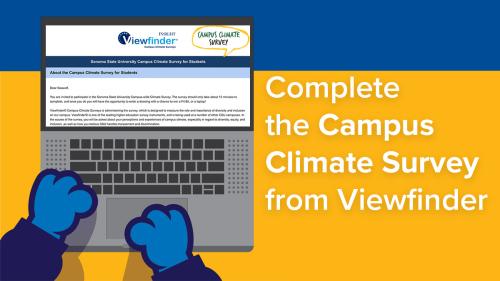Spring 2021 Campus Climate Survey Results
Overview
Sonoma State University’s largest and most comprehensive campus climate survey was administered in both Spanish and English in April 2021 by Viewfinder, a campus climate survey instrument administered by Campus Climate Surveys, LLC - that measures the extent to which diversity and inclusion are part of the university’s infrastructure. Campus Climate Surveys, LLC has worked with dozens of campuses across the country, including a number of CSU campuses. Despite remote work and instruction, pandemic fatigue, and survey novelty, results are substantive and useful, especially in setting a benchmark for future surveys and areas of focus. Our priority, in administering this survey, was to measure a variety of indicators relevant to DEI values and campus climate experiences. Toward that end, we will now have a baseline for future surveys; short and long-term strategic planning; campus practices; and immediate and long-term intervention and action.

Two surveys were distributed, one for students, and one for employees, covering administrators, staff, and faculty. The number of questions to be answered varied between approximately 50 and 60, depending on the survey group. The survey as a whole tested inclusion, belonging, diversity, equity, safety, classroom and work environment, and general campus ethos around DEI values. Some departments have already requested and received a summary of results for their area, and now we have posted the raw data in its entirety below. There were a number of quantitative comments included on returned surveys that were not included in the data results, primarily because they contained identifying information. We are working on a method of coding these comments into our results without compromising anonymity.
Survey Results - Spring 2021
- 2021 Survey Original Instrument - Students
- 2021 Survey Original Instrument - Employees
- Employee Survey Results
- Student Survey Results
- Demographic Identity Reports
Select Core Findings
SSU is largely perceived as safe and welcoming
By and large, our campus cohorts perceive the campus as a safe, welcoming space. For example, 89% of administrators, 82% of staff, 76% of faculty, and 62% of students agree or strongly agree that they feel safe on campus, and 86% of administrators, 82% of staff, 78% of faculty, and 59% of students feel safe off campus. Similarly, 89% of administrators, 85% of staff, 79% of faculty, and 77% of students feel welcome on campus, while 89% of administrators, 85% of staff, 78% of faculty, and 77% of students feel welcome in the surrounding community.
SSU is perceived as diverse and inclusive
These patterns remain consistent in response to the statement, our campus is diverse, with 53% of administrators agreeing or strongly agreeing, followed by 46% of staff, 46% of students, and 34% of faculty. Response to the statement that our campus is inclusive was even stronger, with 70% of administrators agreeing or strongly agreeing, followed by 61% of staff, 61% of students, and 42% of faculty. These numbers mirror and mutually reinforce the response to the statement. There is a great sense of belonging at SSU, with which 63% of administrators agree or strongly agree, followed by 54% of staff, 43% of students, and 39% of faculty.
DEI values require unrelenting focus and persistent reinforcement
DEI values require vigilant attention, in part because unconscious bias and harmful stereotypes are always present to some degree. For example, in response to the statement, I have experienced microaggressions in my department/division/unit on campus, 44% of faculty agree or strongly agree, followed by 39% of staff, 29% of administrators, and 19% of students. When asked if they have ever reported any incident(s) of discrimination, bias, or harassment to campus leadership, 36% of faculty, 34% of staff, 22% of administrators, and 17% of students responded in the affirmative.
We garnered relevant and useful information for analysis and response
There are many other survey items that will help build out a fuller profile, including the extent to which SSU community members can express their gender and/or sexual identity on campus; how readily services related to disability, for example, are accessed; perceptions about which racial and/or ethnic groups are more and less welcomed on campus; and extensive demographic data to help contextualize the whole.

